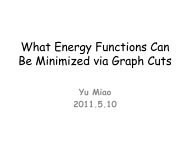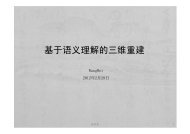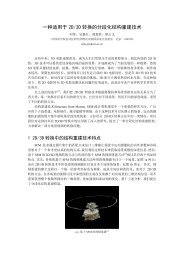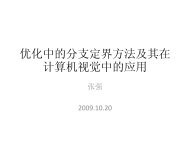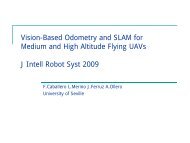Poisson Surface Reconstruction
Poisson Surface Reconstruction
Poisson Surface Reconstruction
Create successful ePaper yourself
Turn your PDF publications into a flip-book with our unique Google optimized e-Paper software.
Eurographics Symposium on Geometry Processing (2006)<br />
<strong>Surface</strong> <strong>Reconstruction</strong><br />
2009.12.29
Some methods for surface reconstruction<br />
• Classification<br />
1. Based on Delaunay triangulation(or Voronoi diagram)<br />
• Alpha shapes<br />
• Crust and Power crust<br />
• Spectral surface reconstruction<br />
• Tight cocone<br />
2. Implicit surface reconstruction ( f(x)=r )<br />
• Hoppe<br />
• Radial basis function surface reconstruction<br />
• Level set<br />
• PDE<br />
3. Parametric surface reconstrucion<br />
B-spline and NURBS
Hoppe’s method<br />
1.Tangent Plane Estimation is defined to be<br />
The center and unit normal are computed so that the plane<br />
is the least squares best fitting plane to<br />
ni is the eigenvector of minimal eigenvalue<br />
2.Consistent Tangent Plane Orientation<br />
Using minimal spanning tree (MST) of the graph with weight<br />
for edge Eij<br />
3.Signed Distance Function<br />
4.Contour Tracing<br />
marching cubes f(x)=0
Marching Cubes
Radial basis function surface reconstruction<br />
This approach is to model the surface implicitly with a function f (x,y, z).<br />
If a surface M consists of all the points (x,y, z) that satisfy the equation<br />
f (x,y, z) = 0<br />
This method involves three steps:<br />
1.Constructing a signed-distance function.<br />
2.Fitting an RBF to the resulting distance function.<br />
3.Iso-surfacing the fitted RBF.
Radial Basis Functions interpolation
Level set<br />
• Given an arbitrary set S = {points, curves, surfaces in N dimensions},<br />
the basic problem at hand is the determination of an N dimensional<br />
surface
Level set<br />
• Determine an appropriate Euler time-step size, dt from the values of<br />
the vector field contributions , curvature contributions<br />
(d(x)) and mesh size, to ensure stability.
2D Voronoi diagram and<br />
Delaunay triangulation<br />
3D Delaunay triangulation
Alpha shapes<br />
• Edelsbrunner's Algorithm
Crust algorithm
The power crust<br />
• Definition: The poles of a sample are the farthest vertex of its<br />
Voronoi cell in the interior of F and the farthest vertex of its Voronoi<br />
cell on the exterior of F.<br />
• Each pole v is the center of a Voronoi ball, which we shall call its<br />
polar ball. The polar balls corresponding to poles inside of F are<br />
inner polar balls; outer polar balls are defined analogously. The<br />
union of the inner polar balls forms a good approximation of the<br />
object bounded by F (we make this quite formal in [3]), and similarly<br />
the union of outer polar balls forms a good approximation of the<br />
complement of the object.
Spectral <strong>Surface</strong> <strong>Reconstruction</strong> (eigencrust)<br />
1. Labeling the poles<br />
a. The Pole Graph construction<br />
b. Spectral Partitioning (Correcting Questionable Poles)<br />
2. Labeling the Remaining Tetrahedra<br />
3. Constructing Manifolds
Tight cocone<br />
1. Marking<br />
2. peeling
Eurographics Symposium on Geometry Processing (2006)<br />
<strong>Poisson</strong> <strong>Surface</strong> <strong>Reconstruction</strong><br />
Michael Kazhdan1, Matthew Bolitho1 and Hugues Hoppe2<br />
1Johns Hopkins University, Baltimore MD, USA<br />
2Microsoft Research, Redmond WA, USA
Abstract<br />
• We show that surface reconstruction from oriented points can be<br />
cast as a spatial <strong>Poisson</strong> problem.<br />
• This <strong>Poisson</strong> formulation considers all the points at once, without<br />
resorting to heuristic spatial partitioning or blending, and is therefore<br />
highly resilient to data noise.<br />
• our <strong>Poisson</strong> approach allows a hierarchy of locally supported basis<br />
functions, and therefore the solution reduces to a well conditioned<br />
sparse linear system.<br />
• We describe a spatially adaptive multiscale algorithm whose time<br />
and space complexities are proportional to the size of the<br />
reconstructed model.<br />
• we demonstrate reconstruction of surfaces with greater detail than<br />
previously achievable.
• Given an oriented point set, we approach the problem of surface<br />
reconstruction using an implicit function framework. Specifically, we<br />
compute a 3D indicator function χ (defined as 1 at points inside the<br />
model,and 0 at points outside), and then obtain the reconstructed<br />
surface by extracting an appropriate isosurface.
Our key insight is that there is an integral relationship between<br />
oriented points sampled from the surface of a model and the indicator<br />
function of the model. Specifically, the gradient of the indicator function<br />
is a vector field that is zero almost everywhere (since the indicator<br />
function is constant almost everywhere), except at points near the<br />
surface, where it is equal to the inward surface normal. Thus, the<br />
oriented point samples can be viewed as samples of the gradient of the<br />
model’s indicator function (Figure 1).<br />
The problem of computing the indicator function thus reduces to<br />
inverting the gradient operator, i.e. finding the scalar function χ whose<br />
gradient best approximates a vector field V defined by the samples, i.e.<br />
Min| ∇χ −V|. If we apply the divergence operator, this variational<br />
problem transforms into a standard <strong>Poisson</strong> problem: compute the<br />
scalar function χ whose Laplacian (divergence of gradient) equals the<br />
divergence of the vector field V,Δχ ≡ ∇·∇χ = ∇·V.
Main content<br />
• Defining the gradient field<br />
• Approximating the gradient field<br />
• Solving the <strong>Poisson</strong> problem
Defining the gradient field<br />
Because the indicator function is a piecewise constant function, explicit<br />
computation of its gradient field would result in a vector field with<br />
Unbounded values at the surface boundary. To avoid this, we convolve<br />
the indicator function with a smoothing filter and consider the gradient<br />
field of the smoothed function. The following lemma formalizes the<br />
relationship between the gradient of the smoothed indicator function<br />
and the surface normal field.<br />
Lemma: Given a solid M with boundary ∂M, let χ(M) denote the<br />
indicator function of M, N ∂M (p) be the inward surface normal at p ∈<br />
∂M, ˜F (q) be a smoothing filter, and ˜F p(q) = ˜F (q−p) its translation<br />
to the point p. The gradient of the smoothed indicator function is<br />
equal to the vector field obtained by smoothing the surface normal<br />
field:
Approximating the gradient field<br />
using the point set S to partition ∂M into distinct patches Ps ⊂ ∂M,<br />
we can approximate the integral over a patchPs by the value at point<br />
sample s.p, scaled by the area of the patch:
Solving the <strong>Poisson</strong> problem<br />
Having formed a vector field V, we want to solve for the function χsuch<br />
that ∇χ =V. However, V is generally not integrable (i.e. it is not<br />
curlfree), so an exact solution does not generally exist. To find the best<br />
least-squares approximate solution, we apply the divergence operator<br />
to form the <strong>Poisson</strong> equation<br />
Δχ = ∇·V.
Problem Discretization<br />
we use the positions of the sample points to define an octree O and<br />
associate a function Fo to each node o ∈ O of the tree, choosing the<br />
tree and the functions so that the following conditions are satisfied:<br />
• 1. The vector field V can be precisely and efficiently represented as<br />
the linear sum of the Fo.<br />
• 2. The matrix representation of the <strong>Poisson</strong> equation, expressed in<br />
terms of the Fo can be solved efficiently.<br />
• 3. A representation of the indicator function as the sum of the Fo can<br />
be precisely and efficiently evaluated near the surface of the<br />
model.
Defining the function space<br />
• Given a set of point samples S and a maximum tree<br />
depth D, we define the octree O to be the minimal octree<br />
with the property that every point sample falls into a leaf<br />
node at depth D.<br />
we define a space of functions obtained as the span<br />
• of translates and scales of a fixed, unit-integral, base<br />
function F : R 3 →R. For every node o ∈ O, we set Fo to<br />
be the unit-integral “node function” centered about the<br />
node o and stretched by the size of o:
• n = 3. Therefore, the function F is supported on the domain<br />
[-1.5,1.5] 3 and, for the basis function of any octree node,there are at<br />
most 5 3 -1 = 124 other nodes at the same depth whose functions<br />
overlap with it.
• Vector Field Definition<br />
• where NgbrD(s) are the eight depth-D nodes closest to s.p and<br />
are the trilinear interpolation weights.<br />
• Since the samples are uniform, we can assume that the area of a<br />
patch Ps is constant and V is a good approximation, up to a<br />
multiplicative constant, of the gradient of the smoothed indicator<br />
function. We will show that the choice of multiplicative constant does<br />
not affect the reconstruction.
<strong>Poisson</strong> Solution<br />
Having defined the vector field V, we would like to solve for the function<br />
χ∈ such that the gradient of χis closest to V, i.e. a solution to the<br />
<strong>Poisson</strong> equation Δχ= ∇·V.<br />
• One challenge of solving for χ is that though χ and the coordinate<br />
functions of V are in the space , it is not necessarily the case<br />
that the functions Δχand ∇ · V are.<br />
• To address this issue, we need to solve for the function χsuch that<br />
the projection of Δχonto the space is closest to the projection<br />
of ∇ · V.
Let , so that we are solving for the vector Then, let<br />
us define the |O|×|O| matrix L such that Lx returns the dot product of<br />
the Laplacian with each of the Fo. Specifically, for all o,o’ ∈ O, the<br />
(o,o’ )-th entry of L is set to:<br />
• Isosurface Extraction<br />
• We choose the isovalue so that the extracted surface closely<br />
approximates the positions of the input samples
• Non-uniform Samples<br />
Estimating local sampling density<br />
Computing the vector field<br />
Selecting an isovalue
examples
Reference<br />
[1] Hoope H. <strong>Surface</strong> reconstruction from unorganized points, In Proceeding of<br />
SIGGRAPH'92[C], chicago:ACM press, 1992:71-78.<br />
[2] Amenta N, Bern M, Kamvyssclis M. A new voronoi-based surface<br />
reconstruction algorithm. In Proceeding of SIGGRAPH'98[c],Orlando, ACM press,<br />
1998:415-420.<br />
[3] Edelsbrunner H, Mucke E P. Three-dimensions alpha shapes[J], ACM Transactions<br />
on Graphics,1994,13(1):43-72.<br />
[4] LORENSEN W., CLINE H.: Marching cubes: A high resolution 3d surface<br />
reconstruction algorithm. SIGGRAPH (1987),163–169.<br />
[5] KOLLURI R., SHEWCHUK J., O’BRIEN J.: Spectral surface reconstruction from noisy<br />
point clouds. In SGP (2004),11–21.<br />
[6] AMENTA N., CHOI S., KOLLURI R.: The Power Crust. In Proceedings of the Sixth<br />
Symposium on Solid Modeling (2001), Association for Computing Machinery, pp.<br />
249–260.<br />
[7] CARR J., BEATSON R., CHERRIE H., MITCHEL T.,FRIGHT W., MCCALLUM B.,<br />
EVANS T.: <strong>Reconstruction</strong> and representation of 3D objects with radial basis<br />
functions. SIGGRAPH (2001), 67–76.<br />
[8] ZHAO H.-K., OSHER S., FEDKIW R.: Fast <strong>Surface</strong> <strong>Reconstruction</strong> Using the Level<br />
Set Method. In First IEEE Workshop on Variational and Level Set Methods (2001), pp.<br />
194–202.<br />
[9] DEY T. K., GOSWAMI S.: Tight Cocone: A Water-tight <strong>Surface</strong> Reconstructor. Journal<br />
of Computing and Information Science in Engineering 3, 4 (Dec. 2003), 302–307.<br />
[10] Michael Kazhdan1, Matthew Bolitho and Hugues Hoppe, <strong>Poisson</strong> <strong>Surface</strong><br />
reconstruction, Eurographics Symposium on Geometry Processing (2006).


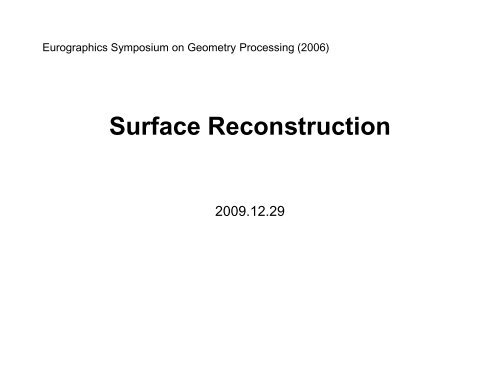
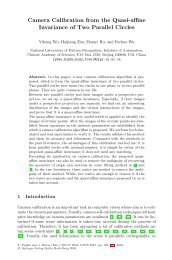
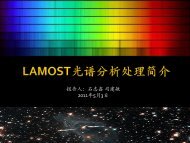
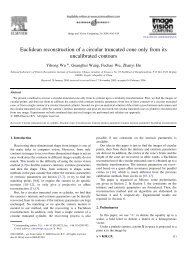
![Accurate, Dense, and Robust Multi-View Stereopsis (PMVS) [1,2,3]](https://img.yumpu.com/19388840/1/190x135/accurate-dense-and-robust-multi-view-stereopsis-pmvs-123.jpg?quality=85)


